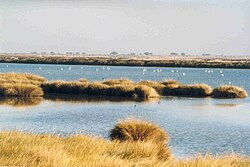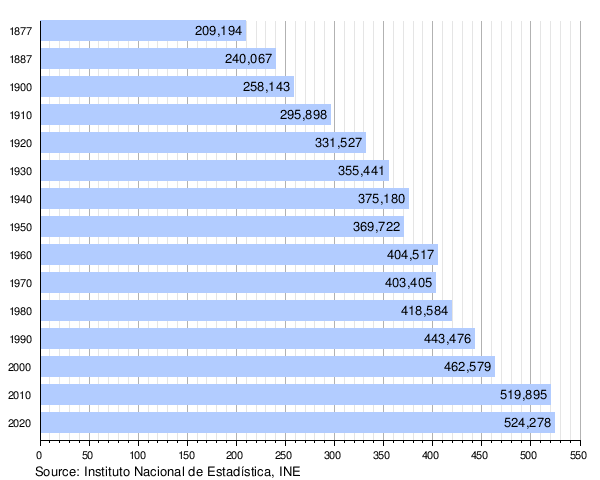Province of Huelva
Huelva | |
|---|---|
 A wetland area of Donana National Park | |
|
Ranked 31st | |
| • Density | 48/km2 (120/sq mi) |
| Parliament | Cortes Generales |

Huelva (Spanish pronunciation:
Its area is
The economy is based on
The province contains
Government and administration
Population
The historical population is given in the following chart:

Tourism
The delayed tourist development of the province has allowed better city planning than in other regions on the Spanish coast. The nuclei of Islantilla and Isla Canela are an example of this attempt to plan in a more coherent form. Although in a smaller scale in comparison to other regions, urban pressure continues. Previous developments that had little planning until recent time are El Rompido, El Portil, Mazagón and Matalascañas (Torre de la Higuera).
Although Punta Umbría had its beginnings like pedanía de Cartaya, after the democratization of summer tourism, it began its urban development for its proximity to the capital and its location on the beach. Present development would not endure without tourist activity and its vacation housing. Other tourist areas are Nuevo Umbría, Nuevo Portil, Punta del Moral, La Antilla and Urbasur. The marismas de Isla Cristina, next to the towns of Ayamonte and Isla Cristina, are a protected nature reserve. In the mountain town of Almonaster la Real, the Visigothic-mosque church built in the first decades of the 10th century and whose mihrab is one of the oldest in Spain is one important turistic point.[2]
Of note is Huelva's recent classification of “rural tourism” for its interior mountain range.
Green electricity
Huelva has 388 megawatts (MW) of wind power, 68 MW biomass power, and 66 MW of solar power.[3] A 220 kilovolt transmission line has been constructed to send power to the main grid as well as improving connections between Spain and Portugal.[4]
See also
- Cerro Colorado mining deposit
- List of municipalities in Huelva
- Labour inspectorate
- Port of Isla Cristina
- Tharsis-La Zarza mining basin
References
- ^ Famous mineral localities: The Rio Tinto mines, Huelva, Spain | Mineralogical Record | Find Articles at BNET
- ^ Jiménez Martín, Alfonso (1998). "La Mezquita de Almonaster la Real". Archived from the original on 6 August 2008. Retrieved 4 June 2008.
- ^ "The province generates 533 megawatts of electricity from renewable energy". EuropaPress, 10 June 2012. Retrieved: 16 June 2012.
- ^ "Iberdrola Renewables starts up the largest wind power facility in Spain". EuropaPress, 11 February 2010. Retrieved: 16 June 2012.
External links
- Official website (in Spanish)
- Natural Park Doñana (in Spanish)
- Natural Park Sierra de Aracena and Picos de Aroche (in Spanish)
- Mine & mineral localities in Huelva at Mindat.org
